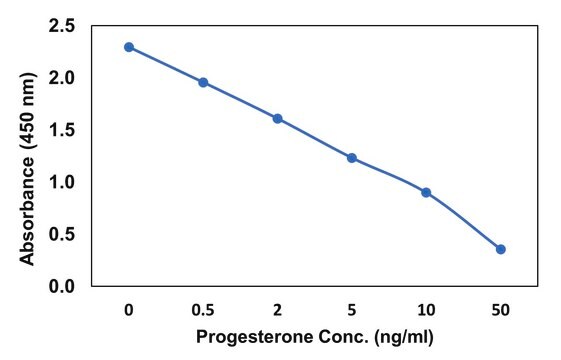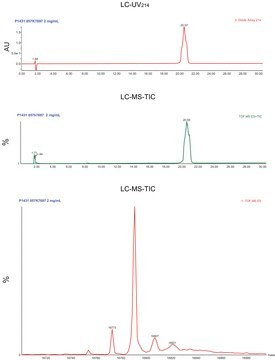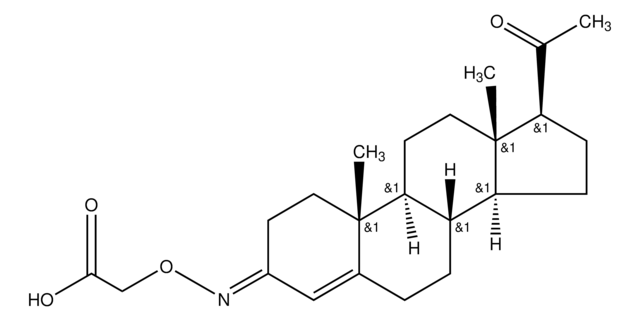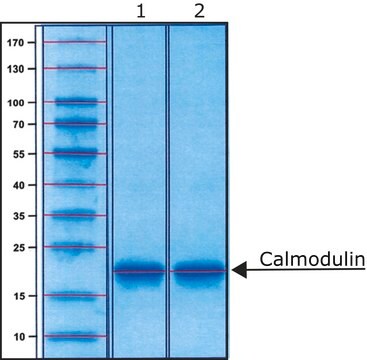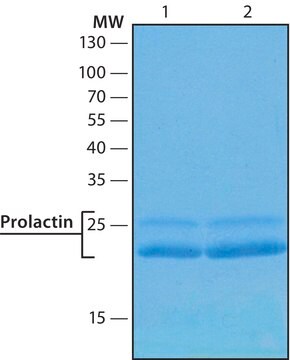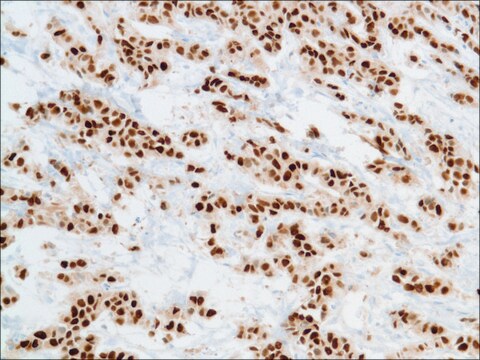P1922
Monoclonal Anti-Progesterone antibody produced in rat
clone 2H4, tissue culture supernatant
Iniciar sesiónpara Ver la Fijación de precios por contrato y de la organización
About This Item
conjugado:
unconjugated
application:
ELISA (i)
RIA
RIA
clon:
2H4, monoclonal
técnicas:
indirect ELISA: 1:1000 - 1:2000 (using Progesterone-BSA for coating.)
radioimmunoassay: suitable
radioimmunoassay: suitable
citations:
10
Productos recomendados
origen biológico
rat
Nivel de calidad
conjugado
unconjugated
forma del anticuerpo
tissue culture supernatant
tipo de anticuerpo
primary antibodies
clon
2H4, monoclonal
técnicas
indirect ELISA: 1:1000 - 1:2000 (using Progesterone-BSA for coating.)
radioimmunoassay: suitable
isotipo
IgG1
Condiciones de envío
dry ice
temp. de almacenamiento
−20°C
modificación del objetivo postraduccional
unmodified
Categorías relacionadas
Descripción general
Progesterone or P4 (pregn-4-ene-3,20-dione) is a female steroid hormone that belongs to the hormones class, progestogens. It is produced by majorly by ovaries, adrenal glands and placenta of humans and other species. Progesterone derived from placenta and corpus luteum is required for the maintenance of pregnancy. Progesterone inhibits the T cell mediated immune response involved in tissue rejection. The progesterone levels in females are low before ovulation and are elevated during the luteal phase. Monoclonal Anti-Progesterone antibody is IgG1 isotype purified from rat cell culture supernatant.
Inmunógeno
progesterone-7-BSA.
Aplicación
The antibody may be used in various immunochemical techniques including ELISA, radioimmunoassay AND RIA to measure progesterone levels in milk.
Nota de análisis
dextran coated charcoal 3H RIA.
Cláusula de descargo de responsabilidad
Unless otherwise stated in our catalog or other company documentation accompanying the product(s), our products are intended for research use only and are not to be used for any other purpose, which includes but is not limited to, unauthorized commercial uses, in vitro diagnostic uses, ex vivo or in vivo therapeutic uses or any type of consumption or application to humans or animals.
¿No encuentra el producto adecuado?
Pruebe nuestro Herramienta de selección de productos.
Código de clase de almacenamiento
10 - Combustible liquids
Clase de riesgo para el agua (WGK)
nwg
Punto de inflamabilidad (°F)
Not applicable
Punto de inflamabilidad (°C)
Not applicable
Elija entre una de las versiones más recientes:
¿Ya tiene este producto?
Encuentre la documentación para los productos que ha comprado recientemente en la Biblioteca de documentos.
Diana Sorg et al.
Journal of dairy science, 100(10), 8205-8219 (2017-08-15)
The objectives of this study were (1) to analyze the agreement of a standard laboratory ELISA for progesterone (P4) with an automated on-farm ELISA kit operated under commercial conditions in 1,297 milk samples from 50 dairy cows; (2) to study
Aenne Honnens et al.
The Journal of reproduction and development, 57(1), 43-48 (2010-10-19)
The objective of this study was to investigate the relationships between uterine perfusion and estrogen, progesterone and the uterine nitric oxide synthase (NOS) system in five trotter mares during the estrous cycle. Color Doppler sonography for measurement of uterine blood
Yinqiu Wu et al.
Steroids, 67(7), 565-572 (2002-05-09)
A series of progesterone-4-ovalbumin (OVA) conjugates with different length linkers (4-, 11-, and 18-atoms long) were synthesized by successive aminocaproic acid homologation of 3-(pregn-4-ene-3,20-dione-4-yl)thiopropanoic acid (1) before conjugation to ovalbumin. The performance studies of these progesterone-4-ovalbumin conjugates showed that the
B C Braun et al.
Theriogenology, 71(5), 754-761 (2008-11-18)
Diagnosis of pregnancies is an important management tool for the Iberian lynx Conservation Breeding Program, a program geared to recover the world's most endangered felid. Non-invasive methods such as fecal hormone analyses are not applicable to the lynx, since fecal
Kim Carnaby et al.
Reproduction (Cambridge, England), 144(4), 477-484 (2012-07-26)
Lynx presents a unique sexual cycle with persistent corpora lutea (CLs) and elevated serum progesterone (P₄) throughout parturition and lactation. In other mammals, CLs normally disintegrate after parturition, therefore the aim of our study was to characterise the annual life
Nuestro equipo de científicos tiene experiencia en todas las áreas de investigación: Ciencias de la vida, Ciencia de los materiales, Síntesis química, Cromatografía, Analítica y muchas otras.
Póngase en contacto con el Servicio técnico